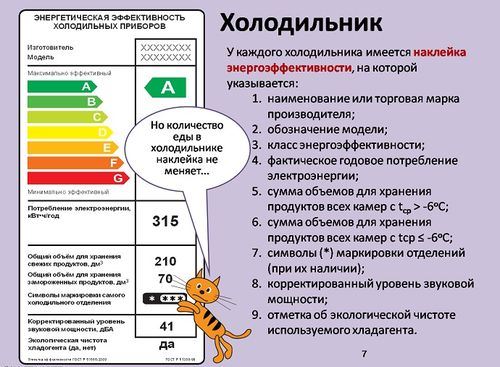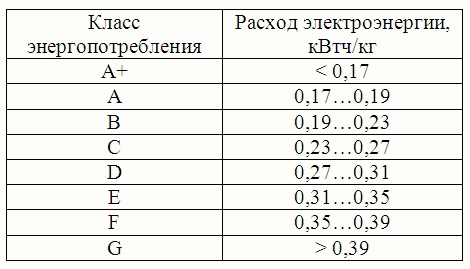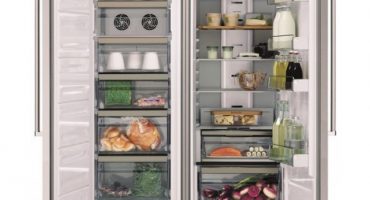One of the important indicators of modern refrigeration units is the amount of power consumption. It determines the operating costs and the value of the electricity bill. The costs of its continuous operation account for more than 30% of all electricity consumed.
The concept and types of power consumption of the refrigerator
Today in the instructions for refrigerators you can find several technical terms: energy consumption, energy efficiency. They are determined by the amount of electricity that is required for the normal operation of all systems of the device. This amount of energy is called the power consumption of the refrigerator. It is measured in watts.
The refrigerator runs continuously. Therefore, an indicative value is the annual energy consumption. The annual power of the refrigerator in kilowatts (kW) is indicated in the technical documentation for a specific device. Typically, minimum and maximum power are indicated.
Using a multimeter, electrical parameters are measured at the time of operation of the compressors. Thus, the average power of any refrigerator is measured. The result shows what the power consumption is in watts.
The most commonly used are two indicators: class and energy efficiency index.

Energy performance indicators
This indicator determines how muchrationally electricity is consumed. For example, a Class A refrigerator consumes approximately 100 watts per hour. Consequently, per day consumption will be 1.5 kW. During the year, it reaches 550 kW.
The main factors affecting power consumption
The total amount of power consumed is affected by technical and organizational factors. The first depend on the design and technical characteristics of the refrigeration unit. The second - from the correct operation.
The first include:
- The internal space of the refrigerator, the number and volume of chambers, the presence of a separate freezer. All these factors determine the total power of the unit. It has been experimentally proved that a refrigerator with a volume of 500 liters consumes about 520 kW / h of electricity per year. The larger the volume, the more electricity is required. However, even large-sized equipment can be quite economical and belong to a high class of energy consumption.
- Quality and reliability of thermal insulation. It protects the interior of the refrigerator from the penetration of warm air in the room. This indicator is determined by the coefficient of thermal conductivity of insulating materials. The higher it is, the more reliable the required temperature is maintained inside. Accordingly, energy is saved to create the necessary temperature conditions.
- Any additional function improves the consumer properties of the refrigeration unit. This leads to an increase in the number of structural elements, and, consequently, increases energy consumption. The only function that is designed to reduce this indicator is the Vacation function. It allows you to maintain zero temperature inside all chambers during the whole time marked as vacation, when the owners are away from home for a long time.
- The presence of special systems for freezing products without ice formation. These include: No Frost, Frost Free, Total frost. All of them require additional electricity consumption. This is due to the fact that periodically the fans are turned on for blowing the evaporator, motors for pumping the cooler.
- The power of compressors, heaters and fans installed in the apparatus.
- The presence and periodic activation of the function of the ice maker.
- The tightness of the refrigerator and freezer.
The second includes:
- The volume, nature, temperature of the products that are planned to be stored in the refrigerator. The larger this volume, the more intensively the refrigeration unit has to work. This increases the consumption of electricity.
- Operating conditions (ambient temperature, amount of space where the refrigerator is located, seasonal factor, location.
- The set temperature settings inside the chambers.
- Frequency of opening doors.
Comparison of power consumption of refrigerators of different manufacturers
In accordance with established international standards, manufacturers use a single system for classifying energy consumption. Each refrigerator has its own energy class. The value of this parameter is placed on the case in the form of a special sticker.

Sample sticker
For marking, capital letters of the Latin alphabet are used. Six of these letters are used - from A to G. The highest class in terms of energy efficiency is the class with the letter A. The lowest, that is, the most energy-consuming, is the class G. Since 2003, + signs have been added to the classification of letters A. The number of these signs determines the level of energy conservation.

The dependence of energy consumption on the class of the refrigerator
The energy consumption characteristics of the most common refrigerators are shown in the table below.
| Model | The volume of the entire apparatus, l | MK volume, l | Class | Energy efficiency index Eei | Electricity Consumption, kWh / year | Noise level, dB | Dimensions HxWxD, cm |
| Atlas XM 4307 | 248 | 80 | A | 21,14 | 299 | 39 | 178x54x56 |
| Indesit T14R | 245 | 51 | B | 22,0 | 404 | 39 | 145x60x66 |
| Lg GA-B409 | 303 | 86 | A | 31,85 | 369 | 39 | 189x59x65 |
| Biryusa 132K | 152 | 0 | B | 32,7 | 430,7 | 38 | 180x60x62 |
| Stinol STN-167 | 290 | 106 | A | 32,81 | 342 | 43 | 167x60x64 |
The most energy-consuming is the commercial equipment, which includes: freezers, refrigerated cabinets, freezers.
Power reduction options
To reduce energy costs, you can use the following tips from professionals:
- It is necessary to determine the list of necessary functions of the refrigerator and its volume. If the number of users is not large, it makes no sense to purchase a large-sized device with new-fangled additions and functions. This will only lead to inefficient use of electrical energy.
- Do not purchase low-energy-class refrigerators. Some Atlant and Biryusa models have a class "B". Today's savings will result in high costs during operation.
- When buying, it is advisable to evaluate all the characteristics of the refrigerator. Analyze existing reviews from owners.
- Use LED devices in the interior lighting system. They are much more economical than incandescent lamps, more durable, have high efficiency.
- The use of energy-saving mode during prolonged non-use of the device, for example, vacation, will reduce energy consumption.
- It must be ensured that the refrigerator doors do not remain open for a long time. According to experts, such negligence increases energy consumption by 70%. In modern refrigerated Atlant, Indesit, Stinol, Lg integrated electronic temperature sensor. It is equipped with a sound signal that is triggered when the temperature drops below the permissible level.
- Monitor the condition of the seals. They provide tightness inside the refrigerator and freezer.
- Provide good ventilation between the back of the refrigerator and the wall of the room.
- Check the temperature of food loaded in the refrigerator. Do not place food and utensils at elevated temperatures. This will require additional energy for cooling and subsequent freezing.
- Monitor the condition of the walls of the refrigerator. Avoid severe icing. Perform periodic ice cleaning and every six months completely defrost the device, followed by cleaning and drying.



